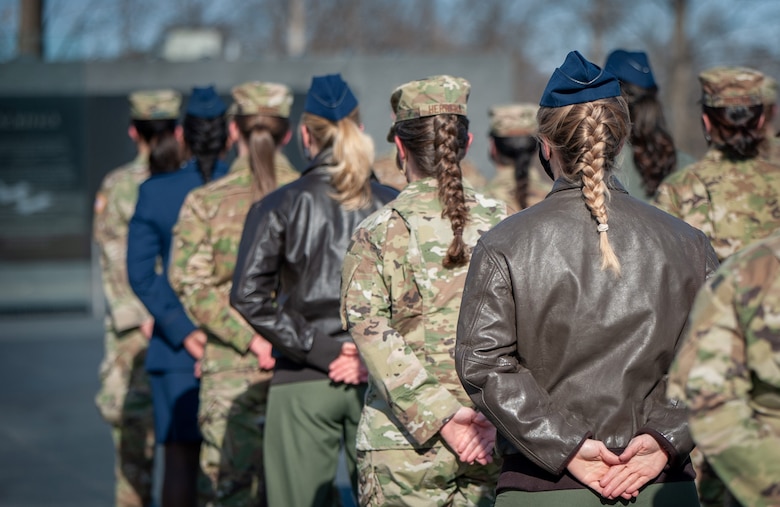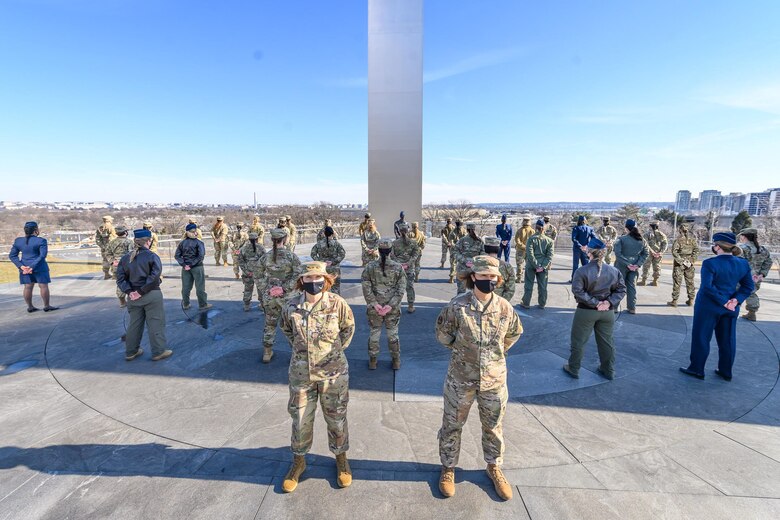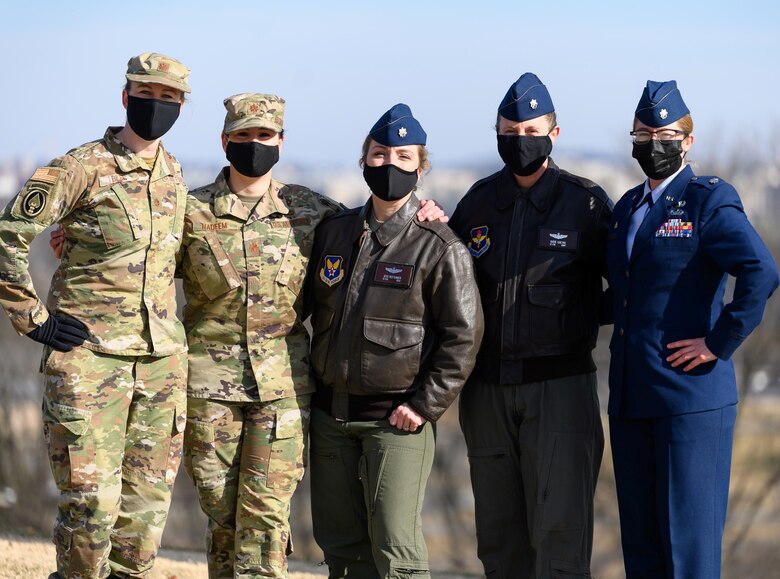Reserve Airmen have been instrumental in helping bring about the first major change in the Air Force's women's hair policy since the late 1940s.
As an outcome of the 101st Air Force uniform board, Air Force women will be able to wear their hair in up to two braids or a single ponytail with bulk not exceeding the width of the head and length not extending below a horizontal line running between the top of each sleeve inseam at the under arm through the shoulder blades. In addition, women's bangs may now touch their eyebrows, but not cover their eyes.
These new changes will be effective upon publication of the new standards in Air Force Instruction 36-2903, Feb. 10.
Maj. Alea Nadeem, a Reserve Airman who serves as the leader of the Air Force Women's Initiative Team, played a key role in bringing about the hair policy change.
"The Women's Initiative Team works to remove barriers for Airmen so they can continue to serve successfully and uses a common-sense approach to change outdated policies," she said. "The women's hair policy has been on the WIT's radar for a number of years."
Nadeem said active-duty Master Sgt. Johnathon Lind deserves a lot of the credit for bringing problems with the old hair policy into the limelight and tirelessly and relentlessly working toward a solution.
"For me, this all started in 2016 when I had a very courageous, young Airman who came to me and told me about all the problems she was experiencing from having to wear her hair in a tight bun all the time," Lind, who currently serves as the noncommissioned officer in charge of air traffic control training for the 4th Fighter Wing, Seymour Johnson Air Force Base, North Carolina, said. "When I talked to my wife (who also serves in the Air Force and was deployed at the time) about this, she told me she was actually considering getting out of the Air Force because of the same problems. I had no idea it was such a problem for my wife and countless other women throughout the Air Force."
Lind and his wife, Tech. Sgt. Jocelyn Lind, started the Warrior Braids Project in hopes of bringing about a change to the Air Force's women's hair policy. Lind interviewed hundreds of women and started working with his various chains of command to try and bring about a change to the policy, with varying degrees of success. Lind said a number of fellow Airmen have been critical to efforts over the years, including Capt. Hailey Garrett, 1st Lt. Natasha Monroe, Senior Airman Emily Stanley-Cruz and Master Sgt. Ashley McCarthy.
In 2019, Lind and Warrior Braids joined forces with the WIT in hopes of accelerating a change in policy.
"We had a lot of great data and the WIT had a lot of great contacts, so our partnership was critical to getting the change approved," he said.
In addition to Lind, Nadeem said Capt. Sarah Berheide and 1st. Lt. Montana Pellegrini have been instrumental in the WIT's efforts to advocate for a change to the women's hair policy. Also, the first historic photos of servicewomen with their hair down were taken by a Reserve Airman, Chief Master Sgt. Jaimee Freeman, the enlisted executive to the chief of the Air Force Reserve.
"Our research and the research done by Master Sgt. Lind showed that the old policy actually had a negative effect on both operational and medical readiness," Nadeem said. "In addition, the policy didn't support a culture of inclusion for almost a quarter of our Total Force Airmen."
Thousands of women across the Air Force provided feedback to the WIT and warrior braids. Many said that constraints to hair grooming standards resulted in damage to hair, migraines and, in some cases, hair loss.
When the time came to seek senior leader support for a new women's hair policy, one of Nadeem's first stops was Air Force Reserve Command headquarters.
"As a Reservist, my first thought was to find out what General Scobee and Chief White thought," she said.
Lt. Gen. Richard Scobee is the chief of the Air Force Reserve and commander of Air Force Reserve Command. Chief Master Sgt. Timothy White is AFRC's command chief master sergeant and Scobee's senior enlisted advisor.
"I wholeheartedly support the WIT's efforts to reform the Air Force hair policy for women," Scobee said. "It's imperative that we implement policies which account for all genders, ethnicities and backgrounds while ensuring leaders continue to foster a culture of inclusiveness. The time is definitely right to change the outdated hair policy for women serving in the Air Force."
"To me, this was a no-brainer," White said. "As a father of two daughters, I could see how the old policy could be a potential barrier for young women interested in joining the Air Force, and I could see how it was contrary to the culture of diversity and inclusion we are constantly striving for."
Scobee and White immediately wrote a letter to the Air Force uniform board in support of women's hair policy reform, saying the proposed changes would "mitigate safety, medical and operational risks, while fostering a culture of inclusion within the Department of the Air Force."
"Eventually, we got letters of support from seven of the nine major-command commanders and more than 40 wing commanders," Nadeem said. "Having the support of General Scobee and Chief White from the beginning was critical to our success."
With the backing of dozens of commanders and years of research and data in hand, the team made its case to the Air Force uniform board in November 2020. In late January, the board announced that the Air Force would be changing its women's hair standards.
In announcing the policy change, Air Force senior leaders expressed their support for the new standards.
"In addition to the health concerns we have for our Airmen, not all women have the same hair type, and our hair standards should reflect our diverse force," said Chief Master Sgt. of the Air Force JoAnne S. Bass. "I am pleased we could make this important change for our women service members."
Nadeem is serving in an Active Guard Reserve position as a Congressional budget and appropriations liaison with the Secretary of the Air Force Financial Management Directorate. She volunteered to be part of the WIT in 2015 while serving on active duty. In 2017, she was asked to lead the team.
"We have more than 600 active-duty, Reserve, Guard and civilian volunteers serving on the WIT," she said. "We are constantly striving to improve the lives of Airmen and their families by working with Air Force leaders to make policy changes. The new women's hair standards are a big win for the Women's Initiative Team and the Department of the Air Force."
"I think this just goes to show what you can do if you don't give up," Lind said. "If you believe what you are doing is the right thing, keep on pushing. You can make a difference."

As an outcome of the 101st Air Force uniform board, Air Force women will be able to wear their hair in up to two braids or a single ponytail with bulk not exceeding the width of the head and length not extending below a horizontal line running between the top of each sleeve inseam at the under arm through the shoulder blades. In addition, women's bangs may now touch their eyebrows, but not cover their eyes. These new changes will be effective upon publication of the new standards in Air Force Instruction 36-2903, Feb. 10, 2021. (U.S. Air Force photo by Chief Master Sgt. Jaimee Freeman)

Lt. Gen. Mary F. O'Brien, deputy chief of staff for Intelligence, Surveillance, Reconnaissance and Cyber Effects Operations, and Chief Master Sgt. of the Air Force JoAnne S. Bass stand in front of a group of female Airmen demonstrating the Air Force's new hair policy for women in front of the Air Force Memorial, Jan. 24, 2021. (US. Air Force photo by Master Sgt. Grant Langford)

Maj. Megan Biles, Maj. Alea Nadeem, Lt. Col. Jessica Ruttenber, Lt. Col. Kathryn Gaetke and Lt. Col. Kimberly Smith pose for a photo during a photo shoot illustrating the Air Force's new hair policy for women. The members of the Women's Initiative TeamWIT were instrumental in bringing about the policy change. (U.S. Air Force photo by Master Sgt. Grant Langford)






